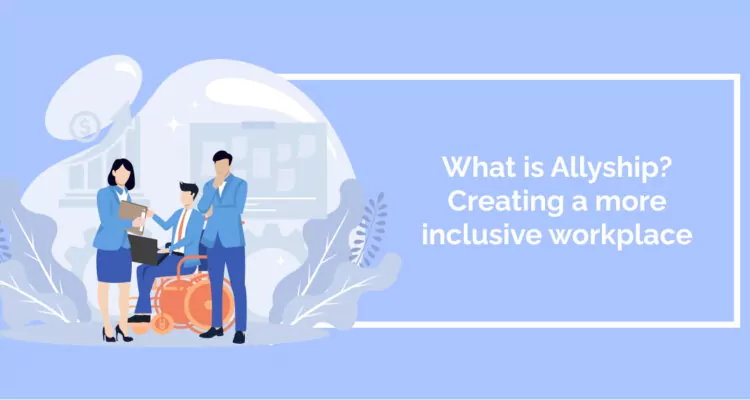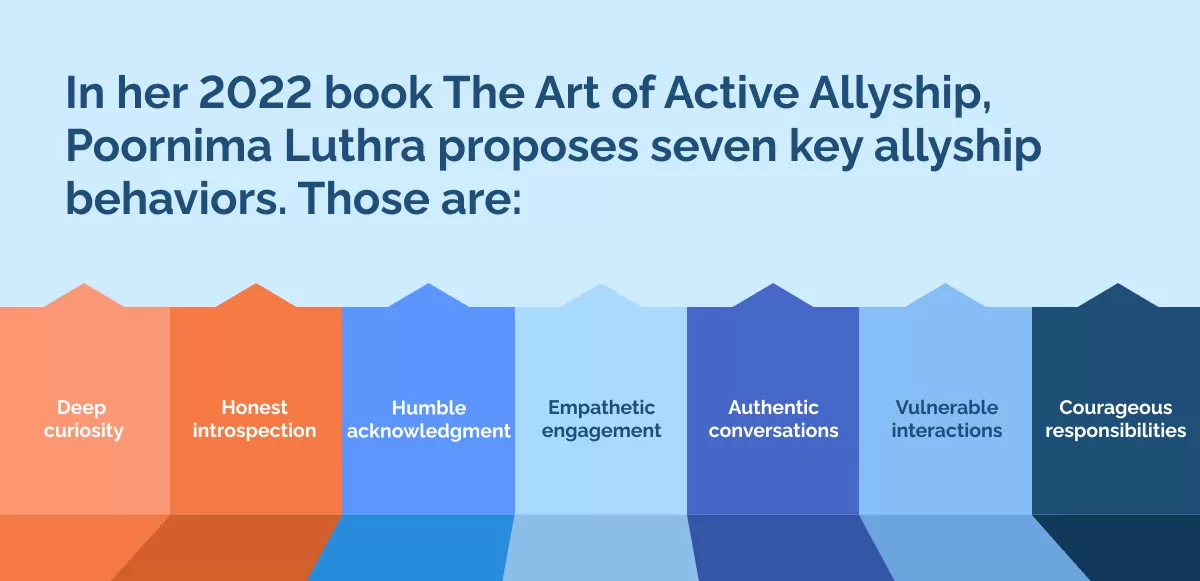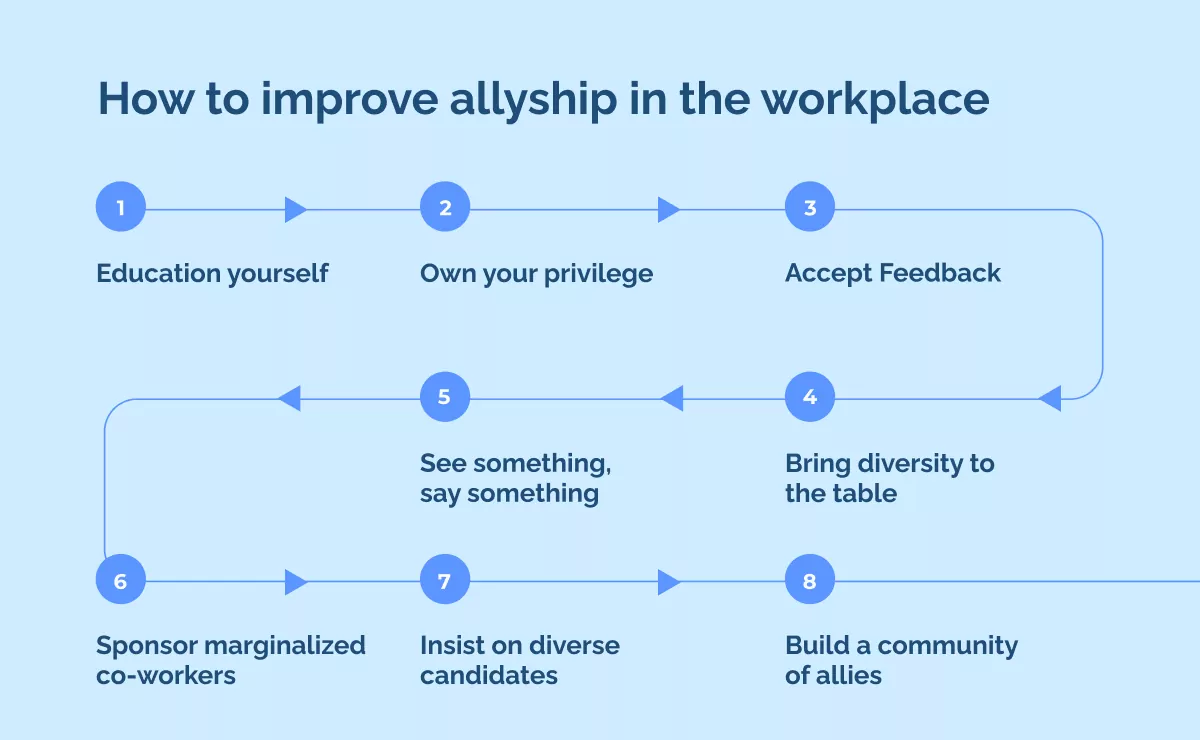
Allyship is a concept and practice in which individuals, particularly those in privileged or majority groups, support and advocate for marginalized or underrepresented groups in their pursuit of equality, justice, and inclusion
For example, allyship involves men supporting women, cis people defending trans people, and white people actively supporting people of color.
Allyship is a much deeper concept than DEI policies and initiatives.
Any company can impose DEI policies on their companies. But it’s not enough: if staff don’t actively support one another as allies, people from marginalized groups will find the work environment hostile and unpleasant.
So, this article will fully introduce the concept of allyship and how it can help people in any workplace. It will:
- Define the concept of allyship fully;
- Show you what allyship looks like in practice;
- Explain how to encourage allyship in the workplace;
- Examine how bad allyship can have a big impact (for the wrong reasons).
Allyship is a great way to take your DEI values to the next level – a progression that remains a challenge in 2023. If your company earnestly asks – “What can we do better?” – allyship is how to create a more inclusive environment for everyone.
Allyship: A simple definition
In the search for social justice, allyship expresses the active support and advocacy for marginalized groups from privileged people. It builds on well-established understandings of feminism and anti-racism, showing that progress can only be made through collective action.
Related concepts include solidarity, advocacy, and empowerment.
In action, allyship might have different forms.
For example, allies might be upstanders for the rights of marginalized groups by challenging toxic policies, calling out episodes of harassment, and criticizing poor company decisions. However, allies can also act as confidants. For marginalized groups, finding someone who will listen to their point of view is difficult. A confidant will quietly build bridges between identity groups to ensure something gets done.
Although this article will focus on allyship in the workplace, it can be extremely valuable in any organizational setting. Allyship may be especially important in the following ways:
- Healthcare organizations: in which marginalized people may suffer from mistaken diagnoses, inadequate care, and poor overall treatment.
- Educational institutions: where marginalized students may be given fewer opportunities than their more privileged peers.
- Local communities: A whole area might be disregarded due to its demographic composition.
In this article, we’ll focus on allyship in the workplace. However, you can learn lessons from any of these areas.
Allyship has become especially prominent in the early 2020s. Dictionary.com recognized its importance in 2021 when they made it their word of the year.
What allyship looks like in the workplace
Allyship is crucial in advancing social justice by addressing a broad spectrum of problematic behavior. Practices such as ensuring equal access, fostering diverse teams, and cultivating inclusive environments serve as excellent foundations.
However, it’s important to acknowledge that many discriminatory acts may go unnoticed by company policies, especially when perpetrated by individuals in positions of inherent privilege.
Some of those behaviors include:
- Microaggressions
- Stereotyping
- Tokenism
- Exclusion
- Cultural Insensitivity
- Unconscious Bias
- Harassment
- Microinequities
- Lack of Representation
- Racial or Gender Profiling
- Lack of Accommodations
- Double Standards
- Language and Communication Barriers
- Inequitable Workload
- Scapegoating
- Systemic Exclusion
In the face of such significant challenges, how can allyship help?

In her 2022 book The Art of Active Allyship, Poornima Luthra proposes seven key allyship behaviors. Those are:
- deep curiosity
- honest introspection
- humble acknowledgment
- empathetic engagement
- authentic conversations
- vulnerable interactions
- courageous responsibilities.
As you can see, these qualities go far beyond administrative policies. They require truly attentive individuals willing to build trust, hear the problems, and respond appropriately. A privileged person who embodies Luthra’s seven principles will listen and act on the knowledge they hear.
How to improve allyship in the workplace

Creating a culture of allyship is not easy. Individual people can take action to become better allies.
In the tumultuous year of 2020, a team at HRB offered some excellent advice for becoming a better ally. The core actions included:
- Education yourself
- Own your privilege
- Accept Feedback
- Bring diversity to the table
- See something, say something
- Sponsor marginalized co-workers
- Insist on diverse candidates
- Build a community of allies
Many of these actions depend on actions from individuals. In today’s society, many privileged people actively want to make a difference – and there are many ways for them to help.
Allyship is hard to implement at an organizational level. After all, allyship is so much about individual actions – a business can’t enforce strict policies to ensure everyone is an ally.
For creating a community of allies, this is where you need a cultural transformation to achieve the results you need. A truly inclusive company culture means everyone will feel comfortable and happy working there. Corporate training programs should target personal skills to produce effective allies.
Allyship means people will challenge the company’s status quo with many difficult conversations. Your leadership team must be bold and fearless to make these changes happen.
Why bad allyship can do more harm than good
In this article, we’ve tried to focus on the positive elements of effective allyship. But there is a dark side, too, and one of the most common problems is performative allyship.
Performative allyship refers to actions taken to gain social approval rather than genuinely advocating for marginalized individuals or groups.
On the surface, performative allyship seems positive. However, it is harmful because it undermines the authenticity of the support offered. It fails to address the root causes of inequality and can perpetuate systemic issues by maintaining the status quo.
Performative allyship often lacks a commitment to meaningful change and can create a false sense of progress, preventing true understanding and dismantling of biases. This allyship can lead to further marginalization, erode trust, and hinder genuine efforts to create inclusive environments.
An effective ally helps to ensure a marginal group’s basic rights. But bad allyship can lead to just the opposite.
Allyship: the key to a more inclusive environment
In 2023, employees are persistently searching for better workplace diversity programs. Gen-Z and younger millennials are especially attentive to how privilege works – which means that the future of work should include the best allyship. Until every marginalized group has the same advantages as the majority group, there will be an urgent need for those with privilege to advocate for others. Able-bodied, male, and white employees can all make a difference.
It is not easy to measure true allyship – after all, it requires people to change their whole selves. However, technology can do a great job of measuring DEI targets. Deloitte research has found that just 13% of companies use technology and analytics to deliver DEI goals. Analytics can be a good adjunct to people trying to be good allies.
WalkMe Team
WalkMe spearheaded the Digital Adoption Platform (DAP) for associations to use the maximum capacity of their advanced resources. Utilizing man-made consciousness, AI, and context-oriented direction, WalkMe adds a powerful UI layer to raise the computerized proficiency, everything being equal.



